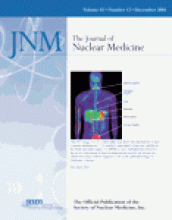TO THE EDITOR:
The recent paper by Min et al. (1), extending earlier work by Delmon-Moingeon et al. (2) and Madar et al. (3,4), is an elegant presentation of the potential use of tetraphenylphosphonium (TPP) as a tumor probe for PET (1). Min et al. contend that the specificity of TPP for tumor imaging would not be compromised by accumulation in inflammatory lesions, which is a problem with 18F-FDG imaging (1). As noted by the authors, TPP is a delocalized lipophilic cation, much like the 99mTc-labeled myocardial imaging agents sestamibi and tetrofosmin, which are also used for tumor imaging. The selective accumulation of this class of compounds in tumors (and the heart) is related to the highly negative inner mitochondrial membrane potential in these cells (2).
However, Min et al. (1) fail to mention that lipophilic cations, such as TPP, sestamibi, and tetrofosmin, are transport substrates for the multidrug resistance transporter P-glycoprotein (5–7). Multidrug resistance refers to a phenotype in which a tumor is inherently resistant or develops resistance to a variety of structurally unrelated chemotherapeutic agents, including such common drugs as anthracyclines, taxanes, and vinca alkaloids. The prevalence of P-glycoprotein overexpression varies greatly among tumor types. Tumors that overexpress P-glycoprotein will show lower accumulation of these tracers than will P-glycoprotein–negative tumors, because of active efflux of the tracer. Indeed, the ∼10% false-negative rate observed in scintimammography with sestamibi and tetrofosmin could actually be a true-negative rate because of multidrug resistance. This reduces the sensitivity of such a tracer for tumor detection, though the tracer may still be useful for tumor characterization.
Thus, in proposing an agent that may be more specific for tumors, they have sacrificed sensitivity. Although there is often a trade-off between sensitivity and specificity in nuclear medicine, in this instance the trade-off could have been predicted from the literature.
REFERENCES
REPLY:
We agree with the comments that TPP is a substrate for P-glycoprotein, as has been published previously. We did not claim that TPP is not such a substrate in the original paper (1) but, instead, that it requires further evaluation as an imaging agent based on the results of our study in comparing it with 18F-FDG. It should also be kept in mind that as modifications to TPP are made to incorporate a positron emitter (e.g., 18F), each derivative will have to be tested as a potential substrate for P-glycoprotein. It may eventually be possible to develop a molecule that is a derivative of TPP and is a poor substrate for P-glycoprotein. This may lead to an imaging probe that is both sensitive and specific. Even if any modified TPP is still a substrate for P-glycoprotein, it may prove to be a useful imaging tracer in many different applications, including characterizing the P-glycoprotein status of a given tumor.







